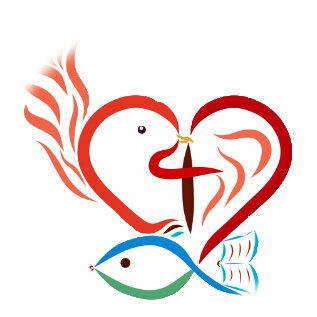Our Church Building
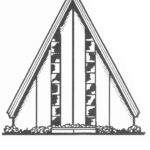
Church Building
The unique design of our present church building can best be appreciated from the west where one gets a spectacular view of the roof line reaching to the sky.
From the parking lot, the two wings of the building reach out like arms welcoming everyone to enter into the spacious narthex for fellowship and into the nave for worship. Upon entering the nave, our eyes are drawn to the large cross and upwards to the heavens. It is the cross of Christ which brings heaven and earth, God and all humanity together.
The first worship service in the new church was on Easter Sunday, March 29, 1964. The building was officially dedicated on May 24.
Members of the building committee were Perry Risberg, Clifford Hanson, Alvin Madson, Richard Gillis, Norval Stensvold, Carl Nordquist, and Pastor Richard Dahlin.
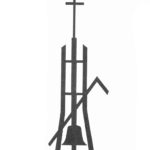
Bell Tower
The bell tower was dedicated at the annual meeting in January 1973. This freestanding structure was designed and constructed to house the church bell which originally hung in the steeple of the old church on the corner of 4th and Michigan.
Olaus Brathen paid his own expenses and traveled by train to select the bell from the McShane Bell Company of Baltimore, Maryland. The bell is a seamen’s bell similar to those used on the coasts of Norway to help sailors get their bearings. It was cast of copper and tin, weighing fifteen hundred pounds and has a loud, clear tone that can be heard for miles, the bell has been calling our members to worship for over one hundred years.
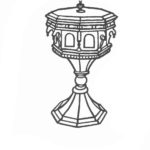
Original Baptismal Font
There are two baptismal fonts in the First Lutheran Church. The one that presently sits in the church narthex was from the original sanctuary. It serves as both a reminder of the congregation’s history and of baptism as the entry into the church family. This font was carved and built by Christ and Henry Olson of Osceola, Wisconsin. The original cover was broken in the mid-1900’s and was replaced with the one now being used. The original cover had a very ornate design that stood more than fourteen inches high.
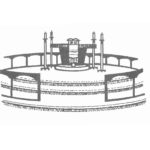
Chancel
The architect’s first design of the chancel in the new church did not meet with the building committee’s approval. Pastor Dahlin drew up the present chancel layout and gave it to the architect, who incorporated it into the final building plan.
The idea was to emphasize God’s eternity by making everything “in the round” – The pulpit, the baptismal font, the communion table and the altar rail. A lectern was omitted in favor of emphasizing the baptismal font. The circular altar rail also emphasized the communion of saints gathered at the foot of the cross.

Credence Table
Prior to the worship service Altar Guild members place the vessels holding the bread and wine for Holy Communion on the credence table. During the offering, the pastor prepares the Lord’s table by placing on the altar the elements that will be used during that worship service. The host is consecrated before being served to the worshippers.
The credence table is from the chancel of the old church where it was primarily used to hold the offering plates. It may have been made by Charles Martinson, a carpenter, builder, undertaker, and church member.
Stained Glass Windows
The stained-glass windows in the sanctuary were started in 1991 and finished in 1993. They were offered by former member, Gay Paulsrud, not merely for beautification, but with the purpose of proclaiming the good news of God’s love for us in Jesus Christ. The windows were designed by artist Deanna Persson, a member of the congregation.
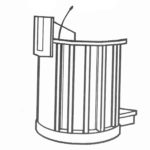
Pulpit
The pulpit was designed with a “round” motif to coincide with the other elements of the church chancel area. This design was to emphasize God’s eternity.
The pulpit has been retired to storage to allow the Pastor to be among the congregation as he delivers the weekly sermon.

Organ
The organ at First Lutheran Church is a totally mechanical action instrument built by Jan van Daalen according to the ideas of organ building established in the eighteenth-century. It contains a total of 867 pipes, ranging in size from approximately nine feet in length and one foot in diameter to as small as a pencil, and are made either from a mixture of lead and tin or mahogany. The pipes are arranged into fifteen ranks or sets and are controlled by the stop knobs at either side of the music rack. Because of the direct mechanical linkage between the keys ad the valves which control the pipes, the keyboards are attached directly to the case, which serves not only an aesthetic purpose, but also serves to focus and blend the sound, much like a bandshell.

Stained Glass - Crucifixion
This window contains the crosses of Jesus and the two criminals in the background. The large draped cross represents the power and majesty of God. The gray, blue sky reminds us of the darkness on the day of the crucifixion. Two women facing left represent Mary, the mother of Jesus and Mary, the mother of Joses. The three figures together represent the women who went to the tomb and found the stone rolled away. The right side of the window depicts the empty tomb. The sun and its light remind us of the glory of the resurrection and also represents Jesus as our eternal light.
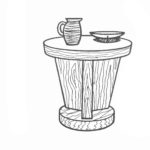
Current Baptismal Font
We enter the church family through the waters of baptism. The baptismal font in the sanctuary continues the “in the round” design theme used in the altar and pulpit. The pitcher and basin are the work of Karlyn Holman of Washburn. They were purchases for fifty dollars.

Lenten Cross
The large, rugged, free-standing cross used during the Lenten season was first used in 1982 for the Lenten Series, “Your Nail,” led by Pastor James Magelssen. At the Ash Wednesday service, everyone was given a nail to carry throughout the season of Lent as a reminder to meditate on the crucifixion and its meaning for your life. At the Maundy Thursday service, each individual’s nail was pounded into the cross. The cross was constructed by Mike Daggett.
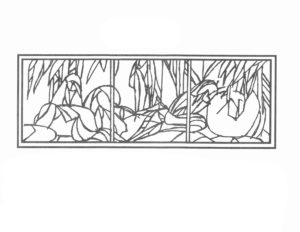
Stained Glass - Gethsemane
This window shows Jesus in the garden of Gethsemane. He had asked Peter, James and John to keep watch as he prayed. When he returned, he found them sleeping. Judas can be seen emerging in the center, with the black and red in his robe denoting the evil for which he has come.
Adapted from the 1998 edition of First Lutheran Church's Cookbook.
Art credits: Herb Kieffer and Deanna Persson
